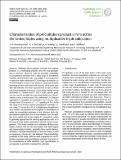| dc.contributor.author | Stoffelen, A. | |
| dc.contributor.author | Alemohammad, Hamed | |
| dc.contributor.author | McColl, Kaighin Alexander | |
| dc.contributor.author | Konings, Alexandra G. | |
| dc.contributor.author | Entekhabi, Dara | |
| dc.date.accessioned | 2015-11-02T19:49:18Z | |
| dc.date.available | 2015-11-02T19:49:18Z | |
| dc.date.issued | 2015-08 | |
| dc.date.submitted | 2015-07 | |
| dc.identifier.issn | 1607-7938 | |
| dc.identifier.uri | http://hdl.handle.net/1721.1/99663 | |
| dc.description.abstract | Validation of precipitation estimates from various products is a challenging problem, since the true precipitation is unknown. However, with the increased availability of precipitation estimates from a wide range of instruments (satellite, ground-based radar, and gauge), it is now possible to apply the triple collocation (TC) technique to characterize the uncertainties in each of the products. Classical TC takes advantage of three collocated data products of the same variable and estimates the mean squared error of each, without requiring knowledge of the truth. In this study, triplets among NEXRAD-IV, TRMM 3B42RT, GPCP 1DD, and GPI products are used to quantify the associated spatial error characteristics across a central part of the continental US. Data are aggregated to biweekly accumulations from January 2002 through April 2014 across a 2° × 2° spatial grid. This is the first study of its kind to explore precipitation estimation errors using TC across the US. A multiplicative (logarithmic) error model is incorporated in the original TC formulation to relate the precipitation estimates to the unknown truth. For precipitation application, this is more realistic than the additive error model used in the original TC derivations, which is generally appropriate for existing applications such as in the case of wind vector components and soil moisture comparisons. This study provides error estimates of the precipitation products that can be incorporated into hydrological and meteorological models, especially those used in data assimilation. Physical interpretations of the error fields (related to topography, climate, etc.) are explored. The methodology presented in this study could be used to quantify the uncertainties associated with precipitation estimates from each of the constellations of GPM satellites. Such quantification is prerequisite to optimally merging these estimates. | en_US |
| dc.language.iso | en_US | |
| dc.publisher | Copernicus GmbH | en_US |
| dc.relation.isversionof | http://dx.doi.org/10.5194/hess-19-3489-2015 | en_US |
| dc.rights | Creative Commons Attribution | en_US |
| dc.rights.uri | http://creativecommons.org/licenses/by/3.0/ | en_US |
| dc.source | Copernicus Publications | en_US |
| dc.title | Characterization of precipitation product errors across the United States using multiplicative triple collocation | en_US |
| dc.type | Article | en_US |
| dc.identifier.citation | Alemohammad, S. H., K. A. McColl, A. G. Konings, D. Entekhabi, and A. Stoffelen. “Characterization of Precipitation Product Errors Across the United States Using Multiplicative Triple Collocation.” Hydrology and Earth System Sciences 19, no. 8 (2015): 3489–3503. | en_US |
| dc.contributor.department | Massachusetts Institute of Technology. Department of Civil and Environmental Engineering | en_US |
| dc.contributor.mitauthor | Alemohammad, Hamed | en_US |
| dc.contributor.mitauthor | McColl, Kaighin Alexander | en_US |
| dc.contributor.mitauthor | Konings, Alexandra G. | en_US |
| dc.contributor.mitauthor | Entekhabi, Dara | en_US |
| dc.relation.journal | Hydrology and Earth System Sciences | en_US |
| dc.eprint.version | Final published version | en_US |
| dc.type.uri | http://purl.org/eprint/type/JournalArticle | en_US |
| eprint.status | http://purl.org/eprint/status/PeerReviewed | en_US |
| dspace.orderedauthors | Alemohammad, S. H.; McColl, K. A.; Konings, A. G.; Entekhabi, D.; Stoffelen, A. | en_US |
| dc.identifier.orcid | https://orcid.org/0000-0002-2810-1722 | |
| dc.identifier.orcid | https://orcid.org/0000-0001-5662-3643 | |
| dc.identifier.orcid | https://orcid.org/0000-0001-9201-6760 | |
| dc.identifier.orcid | https://orcid.org/0000-0002-8362-4761 | |
| mit.license | PUBLISHER_CC | en_US |
| mit.metadata.status | Complete | |
